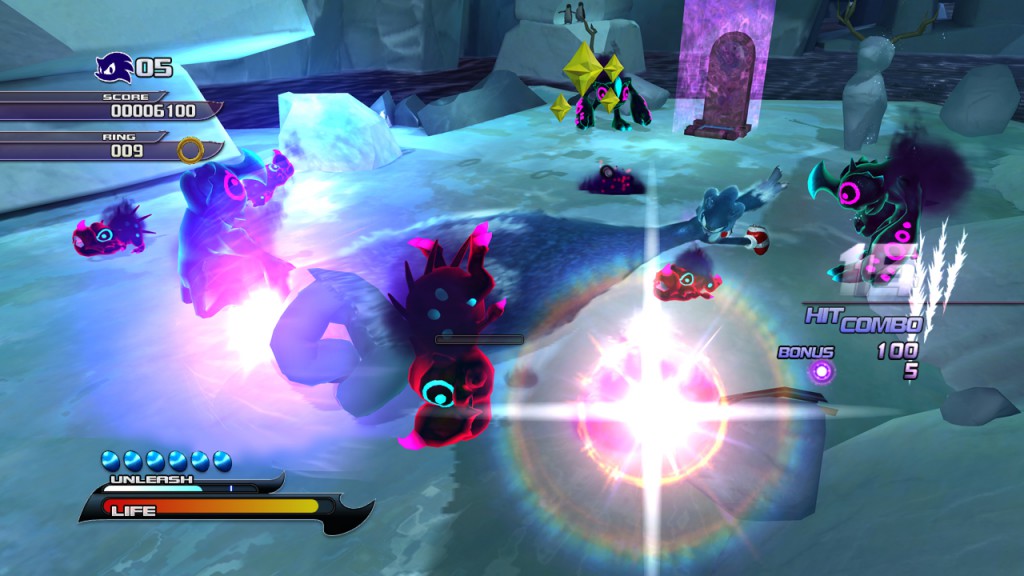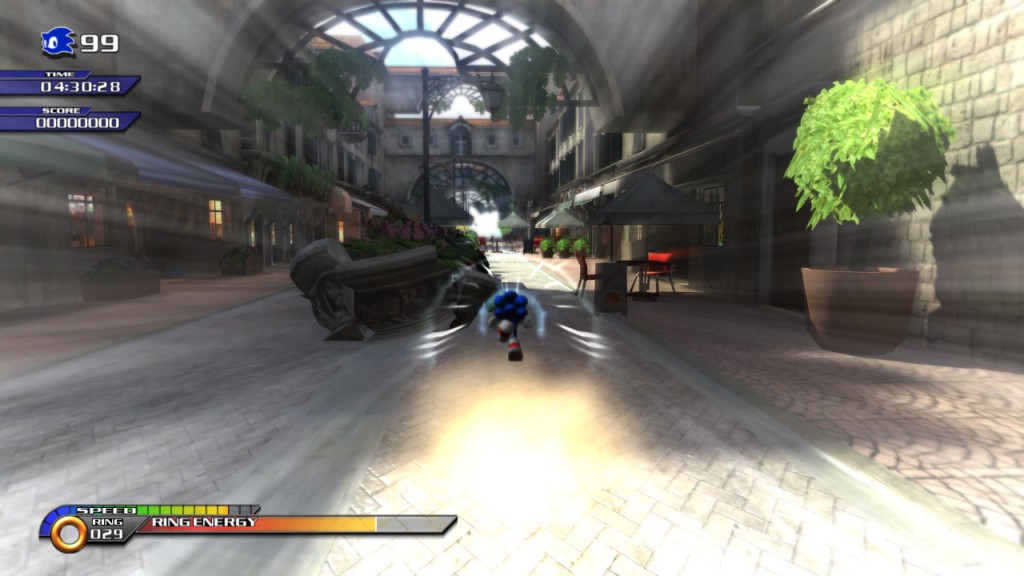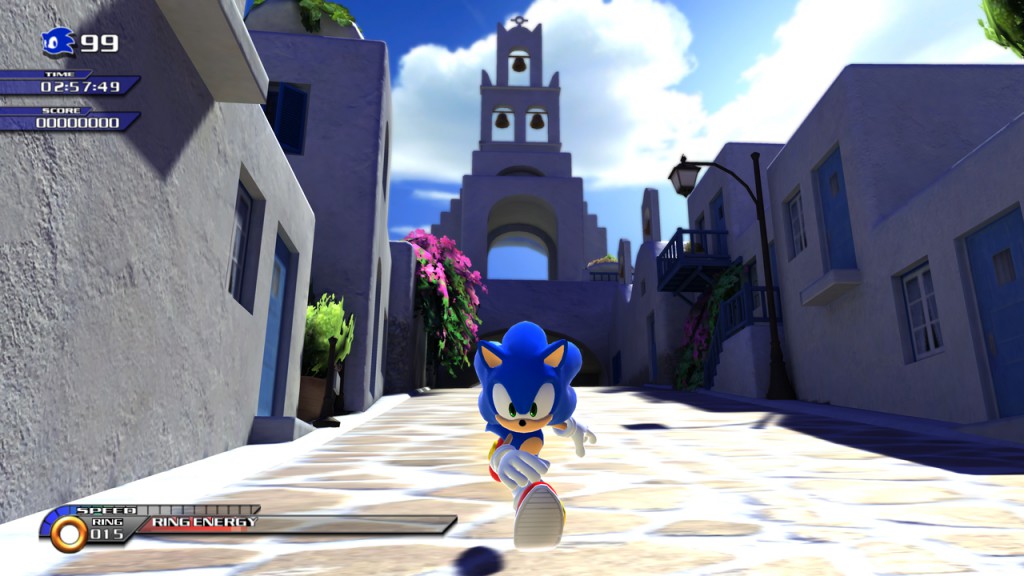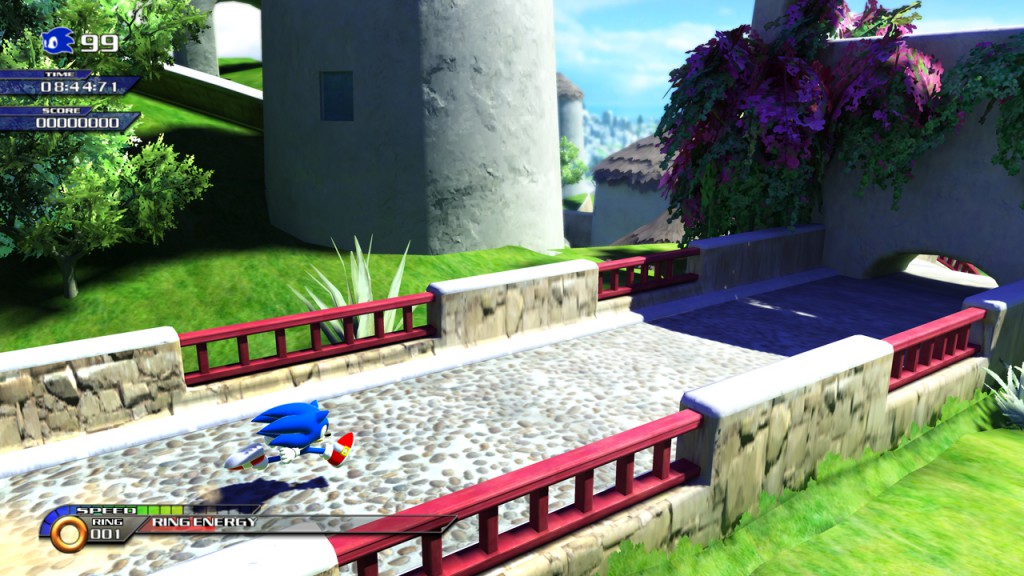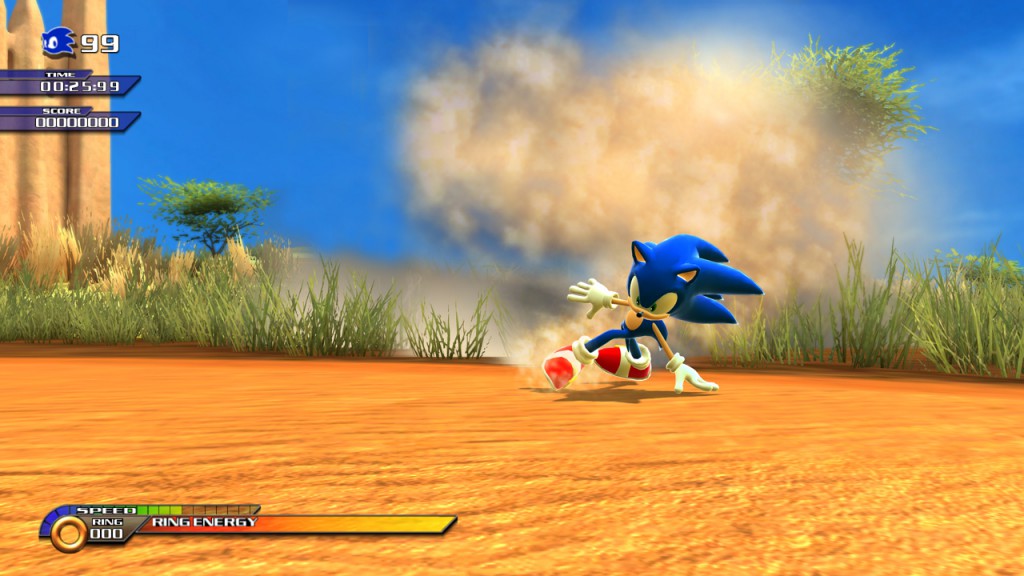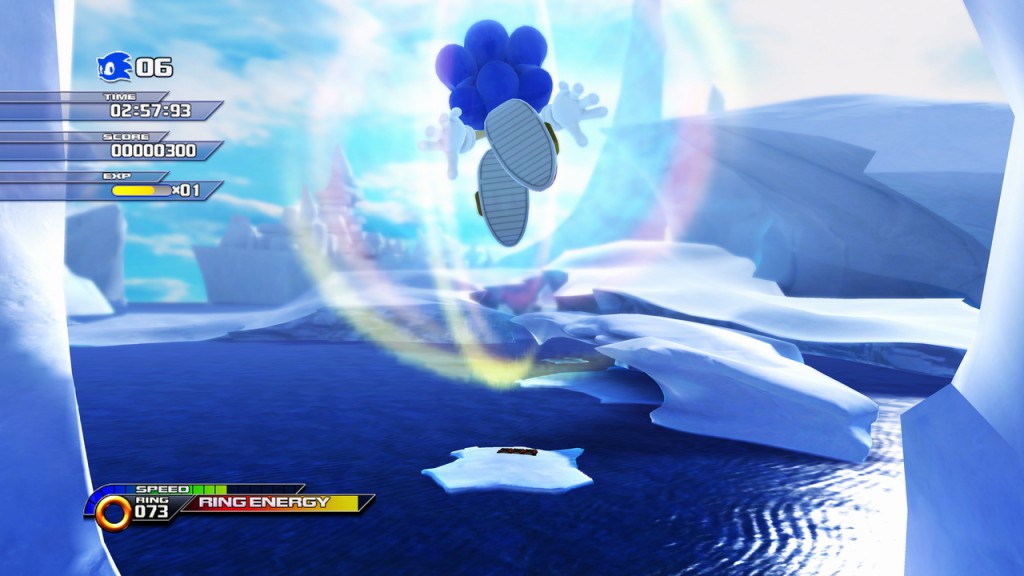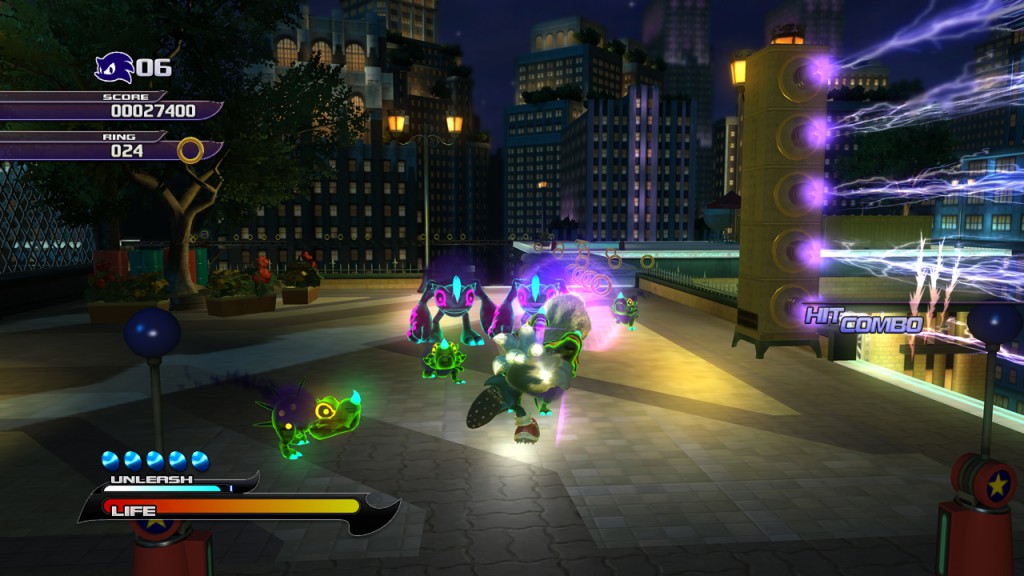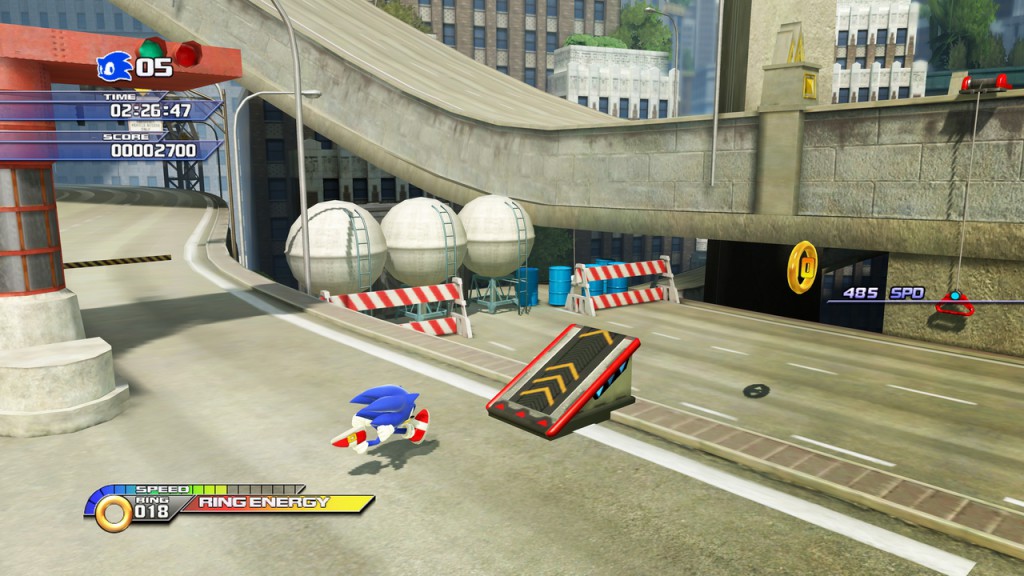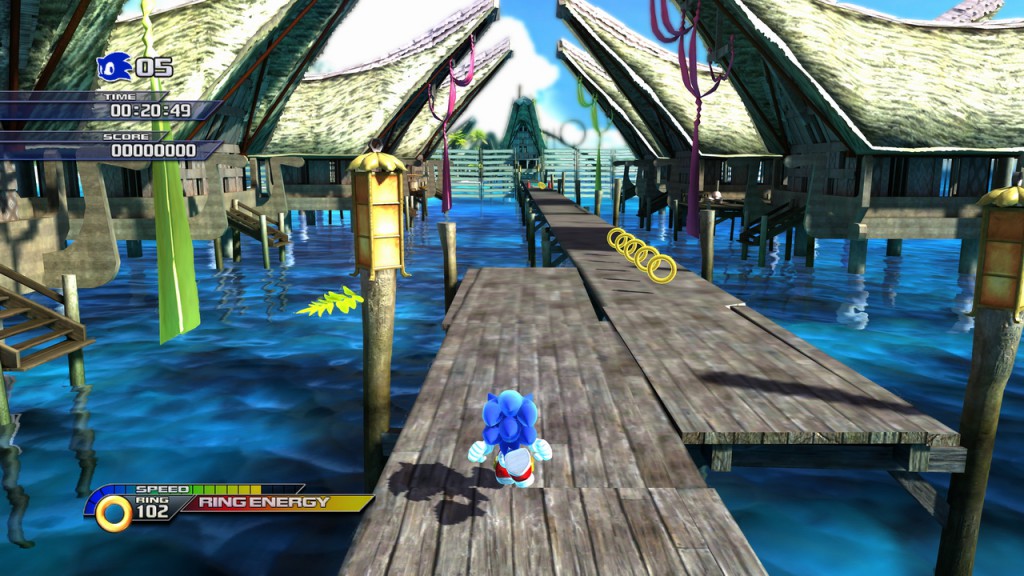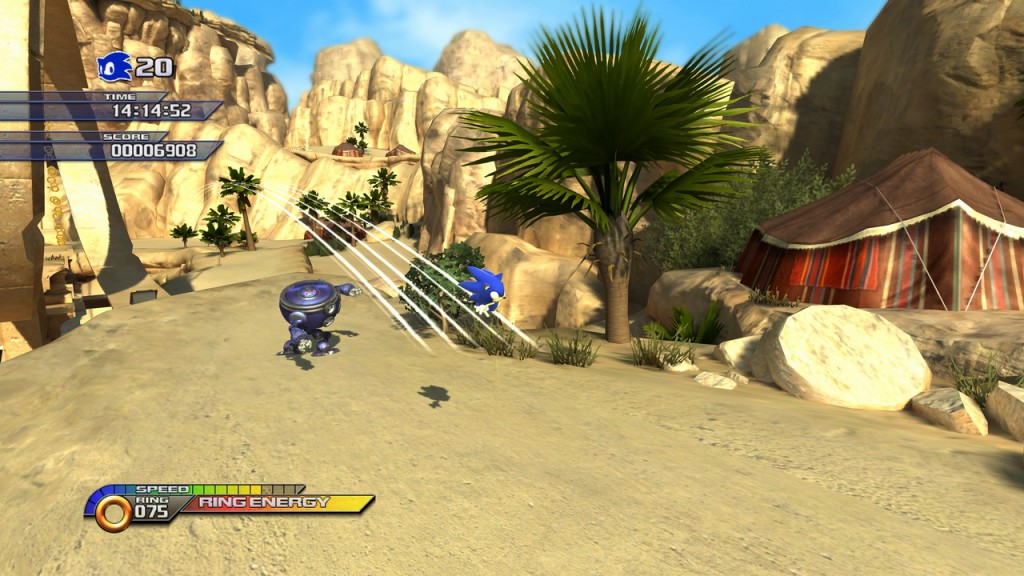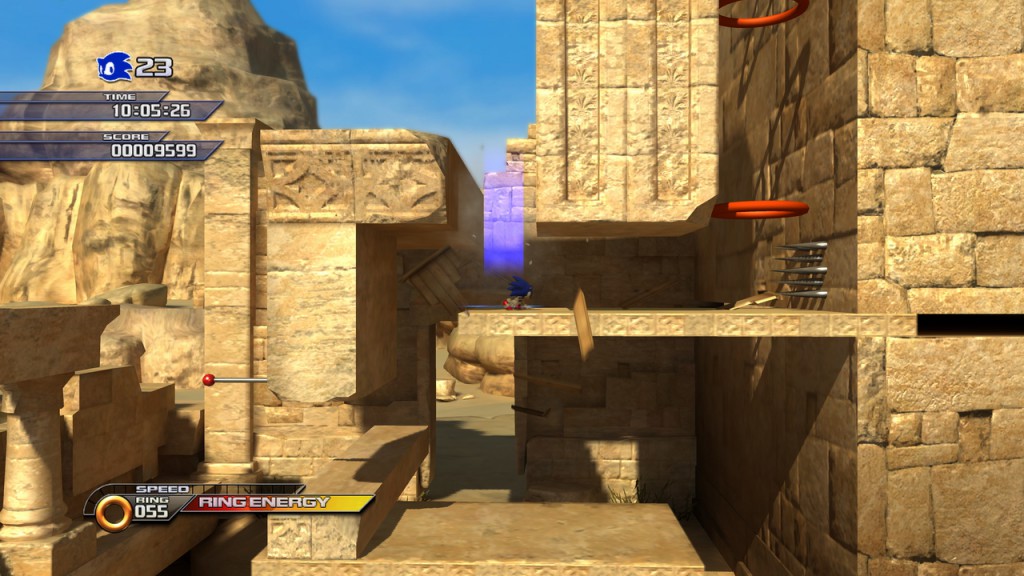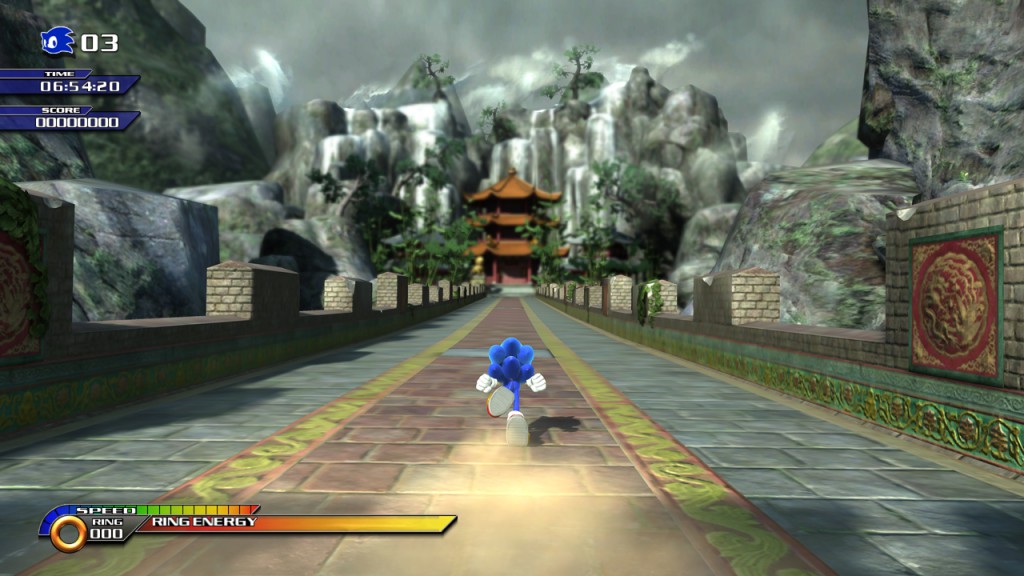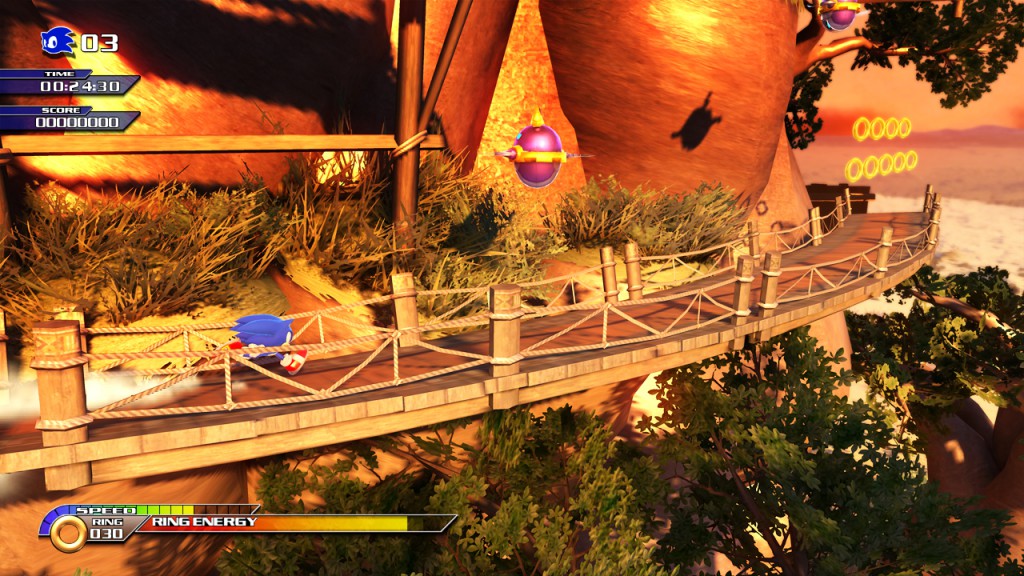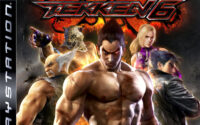Sonic Unleashed Review
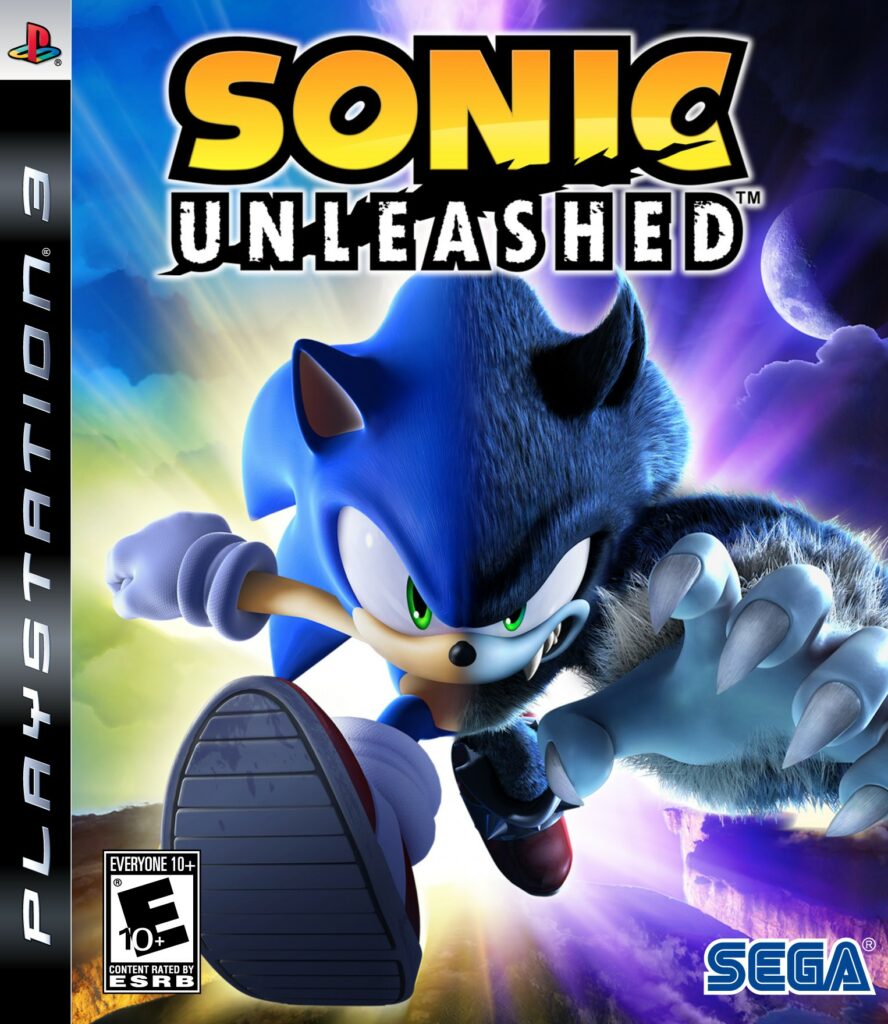
Platforming, fighting and exploration all mixed up in perhaps the weakest Sonic title released to this date.
Story
In an attempt to stop Dr. Eggman’s evil scheme Sonic is attacked by a new ray weapon that utilizes the power of the Chaos Emeralds. Instead of knocking him out it awakens something wild within him – turning him into a werehog at night! The ray weapon also unleashes a powerful beast from within the core of the earth called Dark Gaia. As it arises the world is scattered into pieces, effectively turning planet earth into a series of giant floating islands. In order to restore the world Sonic must take the Chaos Emeralds to the various Chaos Emerald temples of the world.
In his adventure he meets Chip, a little creature who is suffering from memory loss and together they’ll try to set things right once again.
The Game
Sonic Unleashed is a 3D platforming game where you play as the speedy hedgehog known as Sonic. This is the second main line Sonic game released on the PlayStation 3, following the 2006 release Sonic the Hedgehog. The storyline in Sonic Unleashed is not linked to any previous Sonic title, so it can be considered an entirely new chapter.
Sonic Unleashed is played from a third person perspective while the camera follows and allows for both side scrolling action and traditional view.
The goal of the game is to find the Chaos Emeralds and restore the world, and this is done by defeating the bosses that lurk around in the world. In order to get to the bosses though, Sonic must open their seals and this is done by using Gaia Keys that are found scattered all over.
Content
This game is more complex than your average platformer game because depending on whether it’s night- or daytime in the game world, things change; at night, Sonic will turn into a werehog monstrosity and this changes the pace of the game entirely – going from a fast paced platform game to being a hectic brawling feast. Note that the time of day doesn’t change in real time – instead you’ll be able to use a special hour glass switch that changes day to night, and vice versa. Stages are divided into daytime and nighttime acts. Daytime stages tend to be platform heavy speed rushes while nighttime stages tend to be platform based fighting stages. In that respect, it can be said that this game has three main activities – exploring, rushing and fighting.
There’s a level-up function that allows you to allocate experience points on certain aspects of Sonic and the werehog Sonic. There are also some special shoes in the game that will give Sonic new abilities, allowing him to reach new areas. On top of this there are also a wide plethora of souvenirs, food items, unlockable soundtrack records, movie tapes and art book gallery pages to be collected – all for the sake of bonus content and PlayStation trophies.
The daytime stages are typically pretty straight forward and really speedy. They’re quite literally heart stopping because of the insane speed that you’re able to attain in them. The difficulty is often based on timing jumps and avoiding hazards. A fair deal of these stages are scripted, meaning that you’ll follow through loops and trampolines more or less automatically – which has come to be perfectly normal in Sonic games.
There are alternative routes to explore but typically exploration in daytime stages is very dangerous because it’s very easy to fall out of bounds and die because of it.
The nighttime stages are basically composed of rooms with monsters and some light puzzle solving elements such as moving blocks and pulling levers. Obviously, the fighting is the focus here and it’s actually quite deep – there are a fair deal of combos that you can perform and collecting experience points will allow you to unlock new attacks. It can be argued that the fighting is a little bit too easy though, simply because werehog Sonic is so much more powerful than the enemies he’s fighting.
Other than the numerous combos and special attacks you can learn, there are so called critical attacks, which basically are finisher moves that can instantly knock an enemy out. In order to perform these you must press a random sequence of buttons as displayed on the screen – failing will let the monster counter attack you, so that’s a risk you’ll have to take.
Blocking incoming attacks is very easy, but requires some well timed button presses. The monsters that you face are quite predictable because of their limited AI.
You’re given enough health power-ups to keep you alive and kicking even through the harder battles and the werehog is able to enter an unleash-mode so to speak, where he gains invulnerability and superior fighting powers. Of course, this is limited by the unleash-gauge and it can be filled up by bashing away at stuff – be it robots or breakable items.
The game is divided into eight different major areas called villages spread across the world. The further you progress in the story the more of these villages will be available to you. These villages have a central role in the game because that’s where you will be able to speak with NPC’s, buy stuff, search for clues and other secrets. These villages also act as hosts for the entrance stages, which in turn hosts the gates to the actual action/platform based levels of the game.
With that said, the game features more than 30 stages – special challenges, boss battles and optional DLC stages excluded.
Villages and entrance stages are also affected by the time of day in the game – NPC’s will come and go along with the eventual clues they provide. The game typically let’s you choose whether you want to play during day- or nighttime, but in order to progress the story you must complete both types of stages in an illogical order. You’d think that you can do the stages and acts in order, going from one village to another, but that is not the case. Instead you must engage in a storyline that takes you back and forth across the villages of the world and admittedly it’s easy to get lost on the way because the clues you get are vague, to say the least.
For each action stage you clear, you’re free to replay it at any time, for as many times as you want. This comes in handy if you simply want to relive your favorite stages or if you want to better your score etc.
You’re given a five life minimum to beat each stage. You can stack up lives, but you’re always guaranteed five lives when you enter a new stage. If you lose all your lives, you’re simply taken back to the entrance stage where you can enter the stage again, with five new lives. The game never ends as such – the punishment for losing all your lives is that you’re forced to replay the stage in which you died on from the very beginning.
In order to access the various stages, you have to find a certain amount of either Sun or Moon Medals. Each stage has a certain criteria of medals that must be found before its gate can be opened. These medals are hidden all over the game, so a huge portion of the play time will sink into searching high and low for these medals – some of them are really well hidden! In effect, this forces you to replay the same few stages multiple times until you find enough of the hidden medals therein, which in turn unlocks a new stage and thus allows you to progress through the story.
Also, you must meet certain story based criteria before gates can be opened. This combination of medal requirements, story restrictions and the fact that the game is very cryptic about it all is a total mess.
Searching for medals really weighs down the flow of the game down by a whole lot to begin with. The locations of the stage gates are all over the place and many of them only gives you a mocking message that says that you aren’t allowed to enter it – it feels like the game doesn’t want you to play it!
This is the single most disturbing design flaw in the whole game – it’s very deterring to be wanting to play the game but to be forced to do stupid chores and uninspiring exploration of the same few stages over and over again. In practice this means that you’ll have to resort to using a game guide if you want to play the action stages, where the game actually has its qualities, rather than wandering around in the game world wondering where to go and what to do – especially if you’re impatient.
The level design surely has its up’s and down’s. Parts of the game are very easy and fluid, while others are very tricky and even devilish; the difficulty level is unbalanced to say the least. As with any Sonic game, you’ll encounter many traps and hazards and some of them are impossible, or at least close to impossible to foresee. This certainly can bring any honest gamer down but patience is a virtue here.
You’re given check points every now and then and as expected these will function as temporary save-points, allowing you to continue play from there if you happen to die. For the most part, these check points are evenly spaced out, but there are stages where they’re not. In fact, there are stages that doesn’t have any check points at all!
Other times, you’re given an extra life before some of the more difficult parts so that you can keep taking that extra life for as many times you die. While this is thoughtful of the developers, it certainly points to some issues with how the game is designed.
Sonic Unleashed has some ill-natured bugs on its back as well. We’ve seen monsters slide into walls and tracelessly disappear and even worse; monsters that wander off leaving the room where the fight was intended to take place effectively trapping Sonic in limbo – because the game won’t let you leave the room before all enemies are defeated and you won’t be able to reach the enemy because it has left and has no interest what so ever in returning.
Another noteworthy bug is the way Sonic behaves on uneven surfaces – we’ve seen him being flung into random directions just from jumping on a rock, or running near a ledge.
Other than the main story line stages, there are certain NPC’s that will allow you to engage in special challenges. These are typically the same stages that you play in the story but with added rules such as time limits and collecting a set amount of rings. Sure enough, this adds to the value (and the replay value) of the game but it would have been nice to actually have an overview of the challenges rather than having to run around and look for which NPC offers what challenge. As it is now, it just appears to be poorly implemented.
There’s also special missions (or errands, rather) that you can do in the village areas by talking to the various NPC’s. While this does give some additional variation, it doesn’t really raise the value of the game, simply because it’s boring.
Controls
The controls are sadly also suffering from certain issues. First and foremost the camera in this game is flat out troublesome. It appears to be working differently in villages compared to the action stages, which is just confusing. You can rotate it and look around, sometimes at least, and other times it decides to change by itself, potentially interfering with your game. This means that you must be aware of some of the scripted camera changes and compensate for them with your movements.
There are also occasions when the game ignores button presses altogether, leading to many uncalled for deaths as Sonic fails to make a jump, or cling on to a pole that would have saved him.
Aiming jumps with any precision is also bothersome because Sonic, in his normal state moves so fast and in his werehog state he tends to have slippery feet, which means that landing on a ledge will often make him slip and fall right through it.
There are a great deal of actions in the game that uses an automatic targeting system – a few examples are homing attacks, swinging on poles and climbing ledges. There are occasions when the auto-target simply doesn’t appear when it should, making it impossible for you to lock onto the intended target; if the auto-target icon does not appear, you won’t be able to hit the target even if your button presses are dead on accurate.
Known from previous Sonic games are the so called “ring-dashes” where Sonic is able to follow a string of rings automatically by dashing into them. This also works poorly in this game. Sometimes Sonic simply appears to ignore the rings and the dash goes awry, which often leads to death. It’s sure to cause some serious frustration, because it’s often required in order to pass a level and there’s nothing you can do to make it work.
Graphics
The graphics in this game are crippled by some abysmal frame rate issues. There are numerous locations and even entire stages where the frame rate constantly suffers but the nighttime stages are just horrible and embarrassing when it comes to the frame rate. These issues come in your way too often, especially when performing critical attacks as the werehog – when the hardware doesn’t render frames fast enough, (i.e. doesn’t show you what’s going on) it’s impossible to react and get the correct button presses done!
Otherwise, the game looks stunningly good for the most part. There are numerous modern technology graphical shaders in place that make amazing visual effects such as blazing sun light, highly detailed textures, motion blur and real time shadows to name a few.
The game offers many awesome views and it’s all very colorful and well designed overall. Thanks to the fact that the game takes you around the globe, it has many different settings such as snow and ice, jungles, deserts, cities and villages from many interesting cultures resembling (or heavily inspired by) real world cultures. The game world in Sonic Unleashed depicts a voluptuous version of the real world, resulting in a cross-over world of sorts where Sonic and his friends co-exist with human-like people, which is a novel, if somewhat bizarre thought in itself.
Moreover the monster design is very innovative and doesn’t look quite like anything else.
Sound
The soundtrack consists mostly of funk and jazz music that’s heavily influenced by world music as the various songs adhere to confined areas of the world; some influences that stand out extra strong are the African rhythms, European accordions and Mediterranean guitars.
There are more generic songs as well and the daytime act music tends to lean towards funky up beat jazz with saxophones and all. The nighttime stages are have a more relaxed tone, but also has a sticky jazz feel to it. During fights, the soundtrack switches to another hectic jazzy tune that really clashes with what’s going on on the screen – werehog Sonic fighting to a cheesy 60’s Batman / Pink Panther song just isn’t the right way to go musically.
The music in this game is well produced but there simply aren’t enough good songs, so the soundtrack isn’t very enjoyable.
Summary
Sonic Unleashed could have been a sweet game. The graphical issues and even the bugs could have been mostly forgiven, but the thing that really knocks it down is how the general game is designed: tedious emblem searching and trying to figure out what stage you can access and where that stage is, is just a turn-off. Furthermore there are numerous problems with the controls and the game is sure to punish you for every little mistake – whether it’s on your end or not.
At its best, this game is a fun blast with lots of variation, tons of levels to explore and stunning visuals, but its potential is sadly shackled by numerous poor design choices.
